“BEHIND THE CYCLE… Grouse biologist offers answers to fluctuating numbers”
By Dick Ellis
Reader Note: This Dick’s Trip grouse hunting with Ruffed Grouse Society Regional Biologist Gary Zimmer was taken in Price and Sawyer Counties in 2005.
For the Wisconsin Ruffed Grouse, 10 inches of snow forecast for much of state’s northern regions in mid-December meant that a grand gift from nature was building on the western horizon. Unlike so many other species of wildlife whose very survival often depends on a reprieve from deep snow and extended cold, the grouse thrives on just that.
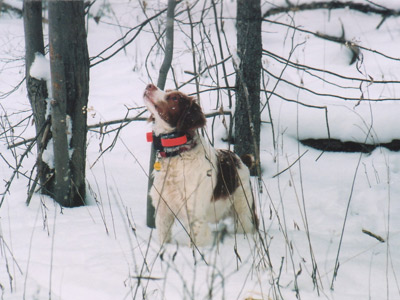 |
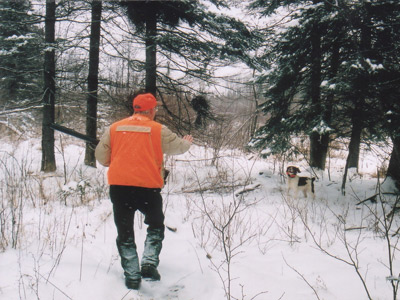 |
|
“After a long and frenzied search, Hunter leaves no doubt that he has pinpointed another Price County grouse roosted in the conifers.” |
“Gary Zimmer, Regional Biologist for the Ruffed Grouse Society, approaches Hunter with a soothing word on Price County public land after the Brittany’s behavior let the owner know that another grouse is holding somewhere in the conifers.” |
According to Regional Biologist Gary Zimmer of the Ruffed Grouse Society, as the snow cover increases, the birds transition from tree roosting in conifers to ground roosting. Snow roosting is so beneficial to the grouse that spring brood production is documented as most successful following the coldest winters with the deepest snow.
By plunging under the snow from on the wing, he said, the grouse finds both extraordinary warmth and protection from predators as grouse tracks and scent become virtually non-existent. The “deeper and fluffier” the snow, Zimmer said, the better.
“With less snow, grouse roost in blowdowns and conifer edges like balsam, fir and spruce with branches tight and low to the ground for protection from predators,” he said. “The key in roosting is always secure cover from strong winds, cold and predators near food sources. It all changes with 10 inches of snow. When grouse can snow roost they experience 30 percent less energy loss and they’re less vulnerable to predators.”
Grouse, he said, roost near their winter food sources and feed for very short periods at both dawn and dusk in particular on the buds of mature aspen. Other food includes the buds or catkins of cherry, yellow and white birch and ironwood.
The grouse’s ability to find food off the ground is an advantage not shared by other avian species. The wild turkey, for example, eats off the ground and if food is not visible, the search for food becomes a “random act of scratching”, Zimmer said. If the search is unsuccessful, the turkey often migrates to wind blown fields for waste grain or manure, or becomes dependent on feeding stations placed by man.
“The ruffed grouse has adapted well to the north woods,” said Zimmer. “Often grouse come out of a winter that has seen deeper snow and a lot of cold in very good shape. Those harder winters are harder on the grouse predators. Avian predators like hawks and owls don’t have a chance because they can’t see the grouse snow roosting. And it’s harder for mammalian predators like fox and coyotes to move in deep snow and to find the grouse without tracks or scent, like it would be for you if you were hunting.”
Zimmer, who will often work the northern counties on snowshoes for grouse, said the explosion of white as the bird rockets from snow roost unexpectedly offers a unique thrill. On the cusp of the storm in an interview from Laona east of Rhinelander December 14, he said only one to two inches of snow cover were on the ground.
“If I hunted this morning I’d look for a mixture of conifer and young aspen with a hazel bush under story,” he said. “Hazel has a catkins seed about one-half inch long that grouse feed on. I’d find a patch of spruce or balsam that enables the grouse to get out of the wind. There are also more blowdown areas up here than there has been the last few years, like tornado areas with fallen trees that also offer protection from the wind.”
By knowing the bird’s habitat of preference and hunting those areas, Zimmer has considerable success despite the current status of the 10 year grouse population cycle. The bird’s numbers fluctuate cyclically over 10 years Three of the last four cycles, Zimmer said, has seen the population bottom out in the year ending in “4” and peak in the “9’ years. For example, 1999 was the last peak year of the cycle, and 2004 was very poor, with peak numbers expected again in 2009.
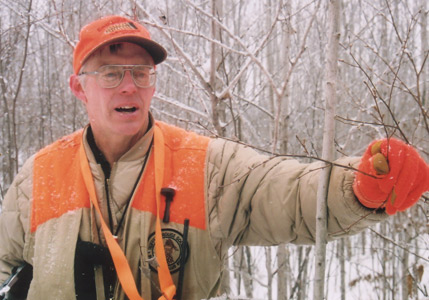 |
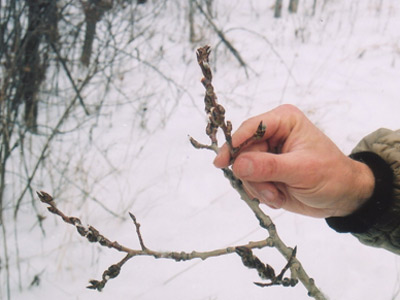 |
|
“The buds of mature aspen, said Regional Biologist Gary Zimmer with the Ruffed Grouse Society, are a nutritional food staple for the grouse throughout the winter months.” |
“The buds of mature aspen, said Regional Biologist Gary Zimmer with the Ruffed Grouse Society, are a nutritional food staple for the grouse throughout the winter months.” |
Although the cause of the cycle has often been the subject of debate, many biologists including Zimmer believe the population in part rises and falls in direct correlation with the cycle of the snowshoe hare and grouse in Canada. When those numbers decline, the Canadian goshawk is forced to migrate south to northern Wisconsin in search of prey.
Here, they join resident avian predators already pressuring the Wisconsin grouse population and grouse numbers fall. It is notable that southern Wisconsin does not experience a grouse population cycle, lending credence to the theory that Canadian birds of prey only migrate as far south as needed to find food.
Wisconsin grouse population increases and decreases do not always correspond with that Canadian prey cycle. Zimmer, then, also believes other factors like regional weather and changes in major food sources also influence grouse numbers.
“We need dry springs for a good hatch,” he said. “If we have cold and wet for prolonged periods, it’s trouble. When we have dry conditions in late May and early June those hens that made it through winter have good broods. We saw that last year. People were seeing 10 and 12 birds three or four weeks old. That is very good. The most eggs they’ll have in a nest are 14.”
Chemical changes in mature aspen buds also periodically occur, he said, seemingly making that diet staple less palatable to the grouse. Those changes could also directly affect the survivability percentage of the birds through winter and the number of birds counted during population census.
Zimmer hopes for another spring in 2006 conducive to high brood production. Two consecutive dry springs, he said, is the key to beginning the population rebound.
He also looks to Minnesota grouse harvest data as a good indicator for Wisconsin the following year. Grouse populations trends, he said, travels west to east, with Gopher state increases in 2005 offering encouragement for Badger hunters in 2006.
“I hope next spring is as good as last and we start seeing numbers bump up,” he said. “Two years together usually does it. Just one good year leaves it pockety. Drumming counts last year were down and this fall slightly up, but it is real pockety. In places with birds there are more than one or two birds. That indicates good brood numbers but with not a lot of hens out there. We could see more nesting hens this year. It’s like the Dow Jones Industrial average. There are ups and downs. I’ve had more ups, but I’m checking out quality habitat.”
 |
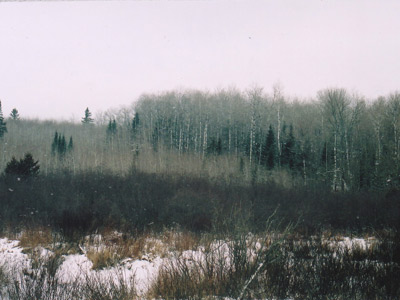 |
|
“Gary Zimmer, Regional Biologist for the Ruffed Grouse Society, stands on the edge of an immature aspen stand in Price County and watches the work of his Brittany, Hunter in the nearby conifers.” |
“This photo taken in Sawyer County December 21 shows ideal winter grouse habitat offering food and shelter from predators and the elements. The shorter tree stand in the background is immature aspen. Mature aspen with nutritious buds, a grouse winter food staple are the taller trees in the background right, intermixed with conifers for roosting.” |
On December 21, Zimmer led this reporter to several areas in Price and Sawyer County with excellent habitat. The winter storm one week before did leave Zimmer’s home county of Vilas with 10 inches of ideal roosting snow. The areas hunted in these more western counties had only six to seven inches leaving us unsure of whether the birds would be able to snow roost, or still in the trees.
“The problem with this late hunting is that you can hunt excellent habitat and still miss the birds,” Zimmer said. “They’re often all together. They might be 50 yards away and you can walk right by them.”
With Hunter, Zimmer’s Brittany pointer, tenaciously showing the way, we worked habitat that held the keys for the ruffed grouse; protection from the elements, protection from predators, and nearby food. According to Zimmer, male grouse have a home range of just six to 12 acres after breeding territories have been set. Females with broods and more need for travel will establish a home range of approximately 40 acres. Incredibly, recent studies show that the grouse will spend much of its life within 600 to 800 feet of its drumming log.
Wednesday morning, for more than one hour we worked the immature, tight aspens, mature aspen and dense conifer stands without a flush. When Hunter found the birds in those conifers though, action remained steady. Approximately one dozen grouse were flushed. Although Zimmer managed just one shot at a fleeting blur of gray, we left with a full limit of what we had really come for; a more intimate understanding of the Wisconsin ruffed grouse.
“We’re very concerned about the future of grouse numbers and grouse hunting,” Zimmer said. “We’ve seen our best years if we don’t get more of a mosaic of young trees and older trees. State and federal land managers have reduced timber cutting. The regeneration of aspen is not always popular. But with that decrease has also come a decrease in grouse and woodcock numbers and in many species of songbirds.”
“What we have in Wisconsin and the Midwest is the best ruffed grouse habitat in the country. But we’re losing the young forest habitat so important to a thriving grouse population. Without a doubt. It’s a challenge to see good wildlife management accomplished through good forest management practices. And it’s fun to watch the benefits come about so fast when good practices are adopted.”
“Like they say in the baseball move, if you build it they will come. If you build their habitat, the grouse will come too.”
For more information contact www.ruffedgrousesociety.org or 1-888-564-6747.







